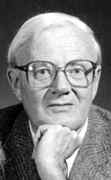Person: Tutte, William Thomas

Bill Tutte was an English mathematician best known for his work on code-breaking in World War II.
Mathematical Profile (Excerpt):
- In 1935 Tutte went up to Trinity College, Cambridge, to study the Natural Sciences Tripos taking chemistry as his major subject.
- It was, however, with his mathematical friends R Leonard Brooks, Cedric A B Smith and Arthur H Stone that Tutte wrote his next paper.
- In the paper which Tutte and his three friends published in the Duke Mathematical Journal in 1940 they associated a graph with a squaring and by looking at the flow of an electrical current through the graph reproved Dehn's theorems and proved many new ones.
- Although this work was for many years covered by the Official Secrets Act, Tutte felt able to talk about it at his 80th birthday celebrations in 1997.
- Using these two messages Tutte was able to deduce the structure of the machine sending the message after four months of intense work.
- By examining patterns in the characters, Tutte deduced that the machine sending the message had one wheel with 41 sprockets, and a second wheel with 31 sprockets.
- Having worked out the structure of the encoding machine purely from the messages, a seemingly impossibly difficult task, Tutte set about writing algorithms decode FISH messages.
- In 1943 the sophistication of the coding was increased and hand decoding using Tutte's algorithms became too hard.
- A computer called Colossus was built to run Tutte's decoding algorithms and their success played a vital role towards the end of the war.
- Rather strangely, although many such as Turing were honoured for their contributions at Bletchley Park, Tutte never received similar honours.
- Despite having no formal qualifications at this stage, Trinity College elected Tutte to a Research Fellowship in Mathematics.
- Tutte was soon publishing papers on many different aspects of graph theory.
- Tutte's paper The dissection of equilateral triangles into equilateral triangles (1948) follows a similar theme to his first mathematics paper on squaring rectangles.
- Donald Coxeter at the University of Toronto had reviewed some of these papers and was certainly fully aware of Tutte's remarkable potential.
- After the award of his doctorate in 1948 Coxeter invited Tutte to take up a post at the University of Toronto.
- Tutte remained at Toronto until 1962 when he joined the faculty at the University of Waterloo.
- Tutte wrote many outstanding papers (Mathematical Reviews lists 168 papers by Tutte) and books.
- Indeed, the style and content of the book betray throughout the influence of Professor Tutte's own work and the distinctive flavour of his personal approach to the subject.
- Tutte has received many high honours for his work.
- In 2001 Tutte received the $5,000 prize from the Centre de recherches mathématiques in Montreal and the Fields Institute for Research in Mathematical Sciences in Toronto.
- Outstanding mathematicians were attracted to work in this field, many of them inspired by Tutte's earlier results.
Born 14 May 1917, Newmarket, Suffolk, England. Died 2 May 2002, Waterloo, Canada.
View full biography at MacTutor
Tags relevant for this person:
Origin England
Thank you to the contributors under CC BY-SA 4.0! 

- Github:
-

- non-Github:
- @J-J-O'Connor
- @E-F-Robertson
References
Adapted from other CC BY-SA 4.0 Sources:
- O’Connor, John J; Robertson, Edmund F: MacTutor History of Mathematics Archive
